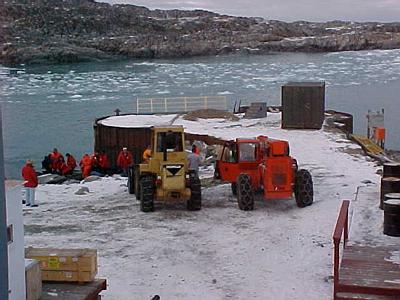28 March, 2000
Tour of the Natty B.
Question 38: Who owns Antarctica?
The RVIB (Research Vessel Ice Breaker) Nathaniel B. Palmer arrived yesterday
afternoon, and both the station and the vessel support staff have been very
busy transferring cargo. The Palmer at 308 feet long and 60 feet wide is a
much larger vessel than the Gould and draws 23 feet. It can not dock at the
station. It has to anchor in Arthur Harbor, and all cargo and personal
transfer is done by Zodiacs. This puts some limits on size and quantity of
cargo and is one of the reasons the Gould is the primary transport and supply
ship for Palmer Station.
We toured the Palmer before she left. The outstanding feature was her size.
Compared to the Gould, the ship most station personnel come over on, the
Palmer is massive. Stairways are at a more normal slant and width; there are
multiple lounge areas, tons of laboratory space (5,600 square feet) and more
deck than you can shake a stick at! The main deck for staging sediment coring
and trawling takes up around a fifth of the length of the ship. Then there is
a smaller upper rear deck for storage and above that a helicopter landing pad
and hanger. The Palmer can support two helos, usually used on biological
cruises rather than oceanographic ones. The winches for trawling can let out
8 km of line, and the trawling bridge supports 60 tons of weight.
The Palmer has 7 levels plus the hold and, above the bridge, an ice tower.
We climbed up three more levels of ladders to end up in the small look-out
room used for navigating in ice. We were 85 feet above the main deck. For
breaking ice, the bow plates are twice as strong as regular steel, the ship
has 12,720 HP (horsepower) in its two main engines, its 13 ft propellers are
encased in cages to reduce ice damage, and it has powerful stern and bow
thrusters. Among the Palmer's state of the art technological tools are a
satellite-based ice imaging system and a multi-beam swath bathymetric mapping
system.
The Palmer is the U.S. Antarctic Program's primary research icebreaker. It
supports a wide range of research in all areas of the Southern Ocean
year-round. It was commissioned in 1992, can break through three feet of ice
at three knots, can stay at sea for 75 days, and has completed over 60
research cruises. This time the Palmer came in from McMurdo, traveling around
the edge of the continent and up the Antarctic Peninsula on an oceanographic
cruise. The scientists on board took water and sediment samples, trawled, and
mapped sections of the sea floor. TEA Larry Reynolds was with them; take a
look at his journal for more details.
Answer 37: The British National Expedition to Antarctica sailed under the
command of James Clark Ross in 1839-1843. It explored further south than
anyone had ever been before. The members of the expedition were the first to
reach the Ross Sea and to see the volcano which was active at the time and
very impressively putting out smoke and flame. Ross' ships were 3-masted
Royal Navy warships, specially strengthened for the ice-filled waters--they
were named the Terror and the Erebus.

Departing personnel getting into Zodiacs at the Palmer dock.

RVIB Nathaniel B. Palmer

RVIB Nathaniel B. Palmer

Bruce boarding the Palmer from our Zodiac.

Contact the TEA in the field at
.
If you cannot connect through your browser, copy the
TEA's e-mail address in the "To:" line of
your favorite e-mail package.
|
